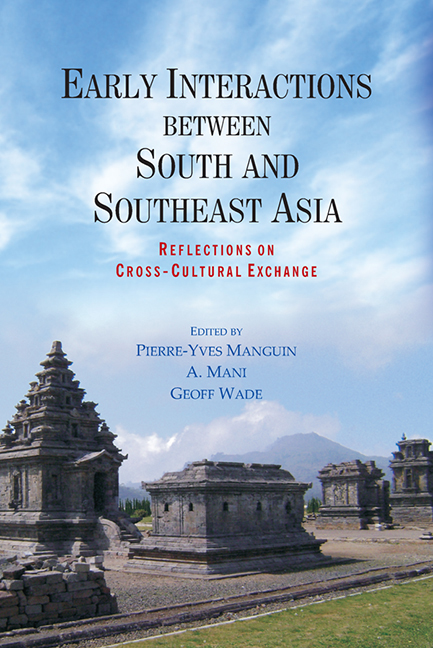Book contents
- Frontmatter
- Contents
- FOREWORD
- Preface
- Introduction
- PART I New Archaeological Evidence from South Asia and Southeast Asia
- 1 Central Vietnam during the Period from 500 BCE to CE 500
- 2 Ban Don Ta Phet and Khao Sam Kaeo: The Earliest Indian Contacts Re-assessed
- 3 Preliminary Study of Indian and Indian Style Wares from Khao Sam Kaeo (Chumphon, Peninsular Thailand), Fourth-Second Centuries BCE
- 4 Early Contacts between India and the Andaman Coast in Thailand from the Second Century BCE to Eleventh Century CE
- 5 The Batujaya Site: New Evidence of Early Indian Infl uence in West Java
- 6 Continuity and Change in South Indian Involvement in Northern Sumatra: The Inferences of Archaeological Evidence from Kota Cina and Lamreh
- 7 South Asia and the Tapanuli Area (North-West Sumatra): Ninth-Fourteenth Centuries CE
- 8 Emergence of Early Historic Trade in Peninsular India
- 9 Contacts between India and Southeast Asia in Ceramic and Boat Building Traditions
- 10 Marine Archaeological Investigations along the Tamil Nadu Coast and their Implications for Understanding Cultural Expansion to Southeast Asian Countries
- PART II Localisation in Southeast Asia
- LIST OF CONTRIBUTORS
- INDEX
9 - Contacts between India and Southeast Asia in Ceramic and Boat Building Traditions
from PART I - New Archaeological Evidence from South Asia and Southeast Asia
Published online by Cambridge University Press: 21 October 2015
- Frontmatter
- Contents
- FOREWORD
- Preface
- Introduction
- PART I New Archaeological Evidence from South Asia and Southeast Asia
- 1 Central Vietnam during the Period from 500 BCE to CE 500
- 2 Ban Don Ta Phet and Khao Sam Kaeo: The Earliest Indian Contacts Re-assessed
- 3 Preliminary Study of Indian and Indian Style Wares from Khao Sam Kaeo (Chumphon, Peninsular Thailand), Fourth-Second Centuries BCE
- 4 Early Contacts between India and the Andaman Coast in Thailand from the Second Century BCE to Eleventh Century CE
- 5 The Batujaya Site: New Evidence of Early Indian Infl uence in West Java
- 6 Continuity and Change in South Indian Involvement in Northern Sumatra: The Inferences of Archaeological Evidence from Kota Cina and Lamreh
- 7 South Asia and the Tapanuli Area (North-West Sumatra): Ninth-Fourteenth Centuries CE
- 8 Emergence of Early Historic Trade in Peninsular India
- 9 Contacts between India and Southeast Asia in Ceramic and Boat Building Traditions
- 10 Marine Archaeological Investigations along the Tamil Nadu Coast and their Implications for Understanding Cultural Expansion to Southeast Asian Countries
- PART II Localisation in Southeast Asia
- LIST OF CONTRIBUTORS
- INDEX
Summary
INTRODUCTION
Any analysis seeking a holistic understanding of the nature of contacts between India and Southeast Asia needs to encompass the interactive dynamics in the larger Indian Ocean region. The Indian Ocean region is geographically divisible into the Western Indian Ocean region consisting of the littoral of Africa, Arabia, Persia and Pakistan and the west coast of India; and the eastern Indian Ocean region covering the east coast of India, Bangladesh and Southeast Asia (Fig. 9.1). The Indian subcontinent, due to its central location, acted as an important meeting locus for the south-western and the south-eastern Indian Ocean regions. The Indian subcontinent was also an important region of cultural production that had lasting impact on the Indian Ocean region. People, ideas, goods, and animal and plant species travelled across the Ocean, perhaps from prehistoric times and such interactions have impacted the socio-cultural formations, directly or indirectly (McPherson 1993; Gupta 2002; Ray 2003; Blench et al. 2005; Dick-Read 2006). Why did people look/travel beyond the Ocean? A number of factors, such as the demand for prestige goods – rather than subsistence goods – and the boost in trade induced by the efflorescence of ‘civilisations’ or early states or population pressure in one region or another, interest in material wealth, curiosity, and the adventurous nature of humans to explore far-off lands, probably, gave impetus to the interactions across the Ocean.
In the area of interactions between India and Southeast Asia, the contributions of India have a higher visibility and often it is not clear in what way Southeast Asia influenced India. This paper presents a discussion on the probable Southeast Asian origin of two technological elements – namely, the ‘carved paddle beating’ technique in ceramic tradition and ‘lashed-lug technique’ of securing planks in boat building tradition – that are represented in archaeological and/or ethnographical contexts in India. For the interactions between India and Southeast Asia, textual sources and archaeological evidence such as architecture, pottery and a variety of artefacts are available. The paper primarily focuses on the two technological elements mentioned above, and hence it is not the intention here to present an exhaustive survey of the entire evidence for the contacts between India and Southeast Asia in ceramic and boat building traditions.
- Type
- Chapter
- Information
- Early Interactions between South and Southeast AsiaReflections on Cross-Cultural Exchange, pp. 197 - 220Publisher: ISEAS–Yusof Ishak InstitutePrint publication year: 2011



